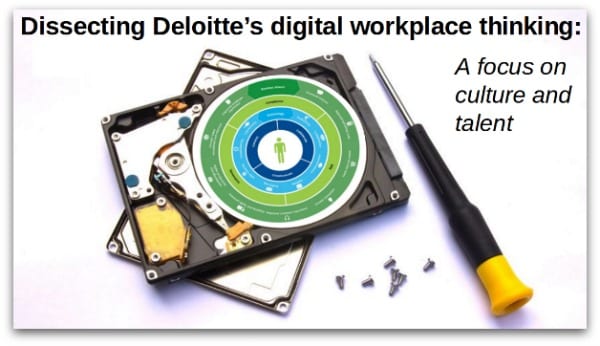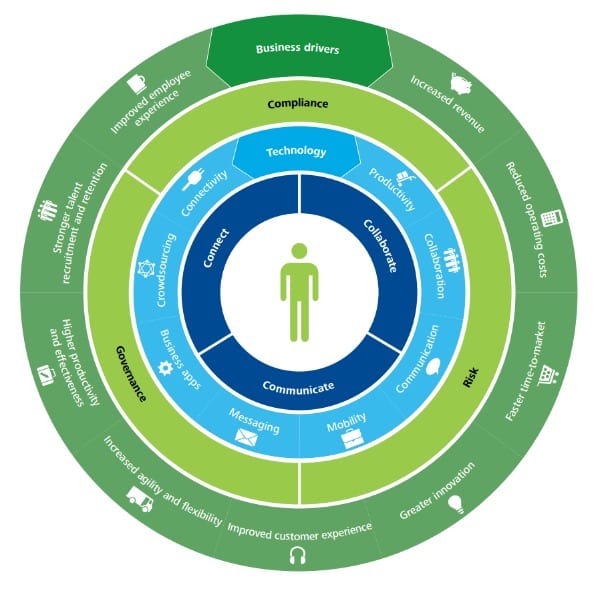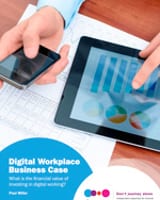Dissecting Deloitte’s digital workplace thinking: a focus on culture and talent

Deloitte has fairly regularly waded into the digital workplace waters and offers a perspective that is mostly about organizational culture and management. Deloitte’s main public digital workplace diagram is perhaps more interesting than useful.
Over the past few years, Deloitte has fairly regularly weighed into the public dialogue about the digital workplace but because Deloitte’s many country-based firms operate somewhat independently, it can be hard to find an official, unified perspective from the company.
Deloitte has, however, published enough material on the web recently for us to get a sense of their core thinking. Deloitte materials spanning the past two years have focused heavily on organizational culture and talent management.
Back in 2011, Deloitte published a white paper about the digital workplace with a very interesting framework and diagram. I haven’t been able to find anything as substantial published since then, so have mainly reviewed this diagram lower down in this article and provided a few thoughts.
A focus on culture and talent
Deloitte’s digital workplace materials have some very specific strengths, namely focusing on organizational culture and talent management. Some of their material is, in fact, quite inspiring.
In an article titled What it takes to be a great digital workplace from October 2015, Andy Main, the leader of Deloitte Digital’s US practice, listed a number of compelling management perspectives:
- Meaningful work: “This growing workforce of digital natives doesn’t just want a paycheck. They want mobility within their career, flexibility with schedule and location for better work-life balance, and collaborative work environments that emphasize creativity and innovation. And ultimately, they want their work to mean something.”
- Flexible career paths: “Give your talent the opportunity to venture out of the standard career paths and customize their jobs to align with their skillsets, interests, and career goals.”
- Work-life balance: “As an organization, it’s your job to make sure your talent doesn’t burn out. That means you should create policies that care for the whole person. This includes obvious things like healthcare and retirement. It should also extend to paid time off and pro-family policies that allow people to maintain a work-life balance – and this should be seen as a business investment, not a cost.”
- Diversity and inclusion: “A supportive workplace also engenders a culture of diversity and acceptance – a key element for creative and innovative environments.”
- Innovation: “To spark innovation, you need supportive management that allows experimentation, rewards smart risk-taking, and sees failure as part of the process in finding the best solution. Opportunities for creative exploration, like think tanks, encourage design thinking and disruptive ideas.”
These concepts for managing people and carefully crafting an organization’s culture create a rich tapestry. They collectively represent a strong approach to talent management which is a key focus of Deloitte’s digital workplace materials.
While this list is very strong, it doesn’t speak much to the digital workplace itself and doesn’t reference any data that suggests a link between the above management concepts and effective delivery on a digital workplace programme.
Emphasis on talent acquisition & retention
The article by Andy Main linked to above put a strong emphasis on the major influx of millennials into the workforce, as well as that generation’s expectations of work.
Similarly, a 2013 white paper by Deloitte in Australia called The Connected Workplace focused heavily on a “war for talent in the digital economy”.
That report put its full weight behind the topic of “digital disillusionment”, a term that DWG’s CEO Paul Miller focused on in Chapter 2 of his recent book The Digital Renaissance of Work: Delivering digital workplaces fit for the future, co-written with DWG’s Head of Research, Elizabeth Marsh.
The “Connected Workplace” PDF report from Deloitte explored data about how well enterprise technology was supporting mobility, flexibility and collaboration. Two interesting findings from the report were that:
- Lack of flexible IT policies correlated to greater likelihood of an employee leaving in the near future.
- Higher levels of collaboration with colleagues correlated to higher levels of job satisfaction.
In a nutshell, young people want good technology, and thriving organizations need forward-looking, adaptive strategies for delivering digital tools.
As with other Deloitte materials, this report provided a fairly low level of detailed guidance on setting up a digital workplace programme, crafting a vision and strategy, governing digital workplace projects, etc.
I also found one other interesting perspective on the digital workplace and organizational culture in Deloitte’s materials.
Digital is about connection
In April 2015, Andy Main put out a short, fascinating article that stated that the true power of digital was connection. He referred to “connection” between people, connections between varied systems and connecting people with data.
The article referenced the term “intuitive enterprise” and described the importance of a digital strategy being really about a corporate strategy. The final two sentences pack a good punch:
“When you get down to it, that’s just a well-run business. Digital is what makes it possible – and personal – at scale.”
These concepts from Deloitte are somewhat more focused on customer-facing digital tools, but align very closely with Paul Miller’s recent talks on how the digital workplace can actually make us more human. For a while now, enterprise technology has been cumbersome, unpleasant and isolating. But with a stronger focus on user experience design (or “design thinking”) and social software, digital workplaces are starting to powerfully connect people with each other and deliver very personalized experiences and information. For reference see DWG’s report Digital Workplace User Experience: Designing for a flexible workforce.
In his 2012 book, The Digital Workplace: How technology is liberating work, Paul wrote about the role of the digital world in breeding isolation and addiction. This is a huge risk, but the flip side, as Andy Main says, is the way in which digital experiences can make personal connections at scale.
An interesting digital workplace framework
Last but not least, in 2011, Deloitte Canada put out the company’s most focused and in-depth public piece of thinking about the digital workplace: A PDF called The digital workplace: Think, share, do – Transform your employee experience.
This paper was quite strong for 2011, when the “digital workplace” term still was very young, and it still holds up today.
As with other materials, it has a strong bent towards talent retention and acquisition. It also puts business drivers in the front seat, rather than seeing the digital workplace though a technology-first lens. The report is a little short on actual guidance, listing useful concepts but only quite briefly.

Diagram from Deloitte’s 2011 paper on the digital workplace
While this diagram includes a focus on business drivers and is visually appealing, I’m not sure it delivers a clear message or offers strategic insights. Deloitte has managed to get plenty of information into one diagram, but the layout doesn’t explain how to manage digital workplace projects or programmes.
Overall, Deloitte’s 2011 paper offered some solid thinking, but I was surprised not to find any major follow-ups since then (as far as I can tell – the 2013 report linked to earlier in this article doesn’t use the term “digital workplace”).
Overall assessment of Deloitte’s digital workplace thinking
As mentioned at the top of this post, it’s a little tough to assess Deloitte because its country firms operate somewhat separately.
But based on the materials publicly available, here are the main themes that emerge:
Big focus on culture: Deloitte appears to view the digital workplace as being closely tied to organizational culture, and rightly so. This focus can lead to very strategic thinking, but also has the potential to stifle pragmatic progress. A recent article by DWG Digital Workplace Consultant Shimrit Janes explores the complex relationship between the digital workplace and organizational culture. Another strong resource on this topic is Jane McConnell’s slideshow on employee engagement and the digital workplace.
Millennial talent as the centrepiece: Much of Deloitte’s digital workplace material orbits around the topic of attracting and retaining talented millennials. This likely resonates for organizations with that as a number one strategic challenge. DWG CEO Paul Miller’s recent post on What a 5 year-old today will expect from the workplace of 2029 looks at this future head on. However, many other business drivers can influence digital workplace projects and the value of effective digital workplace projects can be felt today, not just over the next 15 years.
Business-focused thinking: As with our analysis of Avanade’s digital workplace thinking, at Deloitte we see a clear focus on business strategy and needs, rather than on just technology. This runs very much counter to how many technology consultants see the digital workplace and how some in the IT industry talk about it.
Light on how-to guidance: Despite a strong initial showing as far back as 2011, we’ve seen fairly few resources from Deloitte on digital workplace thinking and strategy. Perhaps that’s because their material sits behind the firewall.
Passing references to user experience: Deloitte’s digital workplace materials do reference user experience and employee experience, but rather briefly. At DWG we’ve found that user experience design (UXD) techniques and perspectives are critical to successful digital workplace projects, but are still too rare in large organizations.
The bottom line: From everything I’ve seen, 2015 has been the year that the “digital workplace” term has come into its own. The value of investing in employee digital experiences is becoming clear and we’re seeing compelling new examples all the time. Deloitte appears to have a very thoughtful perspective on the digital workplace and understands the value that modern digital workplaces can deliver. The company’s lack of publicly available practical guidance is likely about protecting intellectual property rather than an actual lack of delivery skills.
In assessing Gartner, Avanade and Deloitte’s digital workplace thinking, it’s clear to me: We as a society are approaching a massive sea change in the digital experience of work, where user-centred design, a new ethic of meaningful work, and clear business drivers will lead to a digital renaissance of work.
Related research and resources
Business case for the
Digital Workplace

Categorised in: Collaboration, Digital workplace, Internal communications, ROI & Business Case, Strategy & governance
